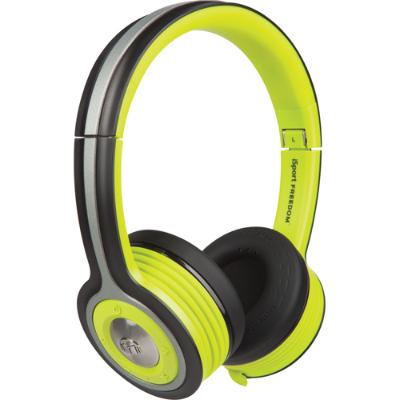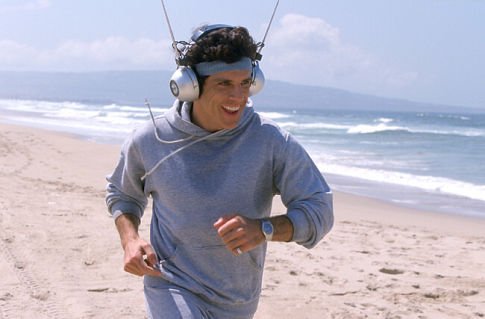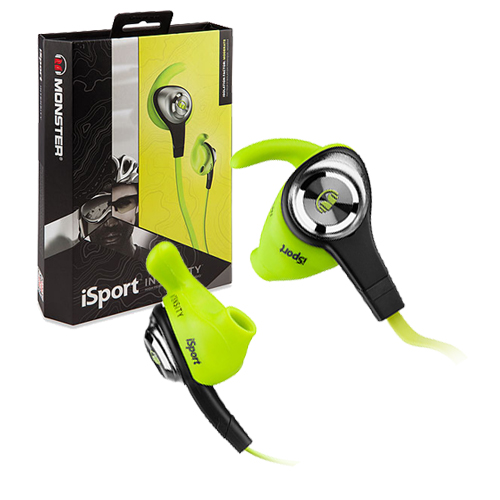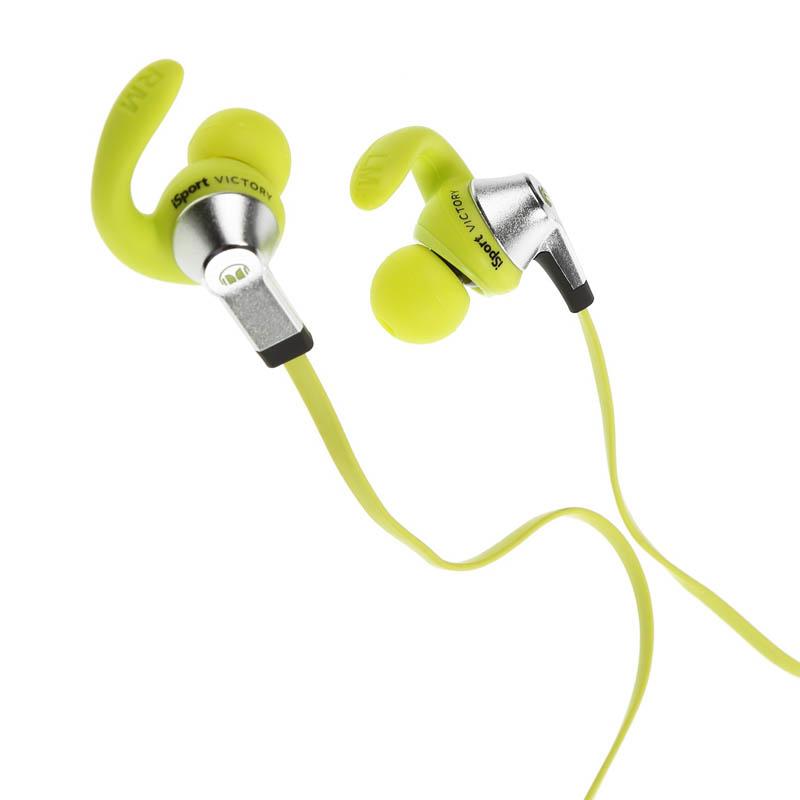 Last November, I had an opportunity to three different in-ear headphone models from Monster’s iSport line – Strive™, Intensity™, and Victory™. While each had their pros and cons, it was the iSport Victory™ that got my vote for the best of the bunch. In fact, since my review, the Victory™ earbuds have become just as much a staple to my workouts as my overpriced stretchy pants. But to throw a bit of a kink in things, I was just sent the latest in the iSport arsenal – the over-ear, wireless, and Bluetooth-enabled Freedom™ headphones. Would they take the place of my beloved Victory?
Last November, I had an opportunity to three different in-ear headphone models from Monster’s iSport line – Strive™, Intensity™, and Victory™. While each had their pros and cons, it was the iSport Victory™ that got my vote for the best of the bunch. In fact, since my review, the Victory™ earbuds have become just as much a staple to my workouts as my overpriced stretchy pants. But to throw a bit of a kink in things, I was just sent the latest in the iSport arsenal – the over-ear, wireless, and Bluetooth-enabled Freedom™ headphones. Would they take the place of my beloved Victory?
Well, I can’t tell you just yet now can I? Before I give you my take on the Victory, let’s quickly recap my earlier review of the three in-ear iSport models.
The Strive is the most affordable and compact model in the iSport line. Like the Intensity and Victory, the Strive comes with three different sizes of SportClips so you can customize the fit to your ears. However, none of the three sizes really worked for me, which made wearing the Strive quite uncomfortable (side note – I have normal ears). Comfort aside, the Strive did what they were intended to do – they stayed put throughout my entire workout; however I did have to make multiple adjustments for fit.
As far as audio was concerned, the quality was mediocre. I found my music to be quite muffled and staticky, no matter how much I adjusted the fit of the ear buds. That said, the Strive did live up to its “best of both worlds” promise by offering partial noise blocking so you can hear what’s going on around you while you listen to your tunes – quite important for outdoor activities where hearing things can be a matter of life and death.
Summary:
- SportClips: 3 – Small, Medium, Large
- OmniTips: None
- Comfort: Poor
- Noise Cancelling: Partial
- Audio Quality: Fair
Next in line is the iSport Intensity earbuds, which (thankfully!) were leaps and bounds more comfortable to wear than the Strive, and also stayed put through a ridiculously grueling workout. Like the Strive, the Monster Intensity headphones’ patented Sound Channel design seals in music while allowing some background noise to come through, however, the level of noise blocking was definitely a step above (moderate as opposed to partial), which I really liked.
Like the Strive and the Victory, the Intensity come with ControlTalk Universal™, which allows you to take incoming calls by clicking a button on the headphone cable. I’m not a big fan of this feature, because for the most part, when I am listening to music on headphones, I’m typically engaged in an activity where phone calls are unwelcome. But, I’m sure it is a big “plus” in many people’s books. The Intensity also feature control buttons so you can easily play, pause, and adjust volume – the Strive do not.
Summary:
- SportClips: 3 – Small, Medium, Large
- OmniTips: None
- Comfort: Great
- Noise Cancelling: Moderate
- Audio Quality: Great
To say the Monster iSport Victory headphones are comfortable is an understanding. In addition to three sizes of SportClips, the Victory earbuds also come with three sizes of OmniTips, which replace the silicone eartips. The combination of the right size of SportClip and OmniTip makes for an insanely snug and comfortable fit. From burpees to sprints, to crab walks and squats, to sparring and crunches, the Victory earbuds stayed firmly in place.
Plus, the sound quality that pumps through the Victory headphones is superb. The bass is loud without being hollow, and the clarity is just fabulous. This might also be due to the fact that unlike the Strive and Intensity, the Victory headphones are said to provide full noise cancelling. That said, I was still able to hear shouting and grunting at the gym, so they aren’t completely noise cancelling.
Summary:
- SportClips: 3 – Small, Medium, Large
- OmniTips: 3 – Small, Medium, Large
- Comfort: Great
- Noise Cancelling: Full
- Audio Quality: Fabulous
And now, without further ado, let’s talk about the Freedom.
Like the in-ear models in the iSport line, the Freedom is a vibrant neon colour, so you can be sure that you’ll stand out from the crowd as you run, jump, lunge, hike, and volley your way to your best self. The Freedom also adheres to iSport’s “durable, water-resistant, sweat-resistant, and antimicrobial” mandate, which is pretty impressive considering the fact that unlike the Strive, Intensity, and Victory, the Freedom are over-ear. What?! Mind blown? Ok, perhaps not, but here’s the skinny on the Freedom.
 Why Freedom?
Why Freedom?
Contrary to what you might think, these headphones are not called “Freedom” because they free you of the inner ear canal pain that inevitably comes with wearing earbuds for extended periods of time. Nope, they are called Freedom because they are completely wireless.
Side note – as I was testing these headphones I may have had fits of giggling because I kept envisioning Ben Stiller running on the beach in his 1970’s version of over-ear wireless headphones in Starsky and Hutch. But I digress …

Box Opening, Design, & Set Up
In true iSport fashion, opening the Freedom package was a real experience and the design would make any marketer proud. On one side of the box there was an instruction booklet tucked neatly into an interior envelope that showcased the Freedom’s main functions via six bullet points and a side-view image of the headset. On the other, neon green headphones folded in on each other. While I’m not a huge fan of the colour, the second I removed the Freedom headphones from their protective enclosure, I immediately noticed that they had a little something-something going for them that I have yet to see in any other over-ear head set – they were remarkably flexible. Like anyone would do, I twisted and cranked them all sorts of directions and the Freedom willingly moved with me. While I would hope no body’s head would move in a similar fashion, the Freedom make it clear from the outset that they are headphones that will stick with you no matter what you are doing, and will withstand the abuse that is inevitable in any set of headphones.
The Freedom headphones are also adjustable, and feature a strip of reflective material that ensures you are seen when jogging, biking, or even just walking down the street.
Immediately after locating the USB cable, I searched the headset and after what seemed like several minutes (was likely 4.5 seconds), I found a very unobtrusive rubber cover that opened to reveal the USB port; I could have located this port had I looked at the instructions, but I don’t have the patience for instructions. I plugged the other end into my laptop and waited less than two hours for the Freedom to charge. I then pushed the power button, went to the Settings on my iPhone to search for available Bluetooth devices, clicked on “Freedom,” and set up was complete. Outside of charging time, set up took less than one minute.
 Usage & A Little More Design
Usage & A Little More Design
As mentioned, set up was a breeze, and as soon as I was connected to my iPhone via Bluetooth, I just had to select my music stream, press play on either my phone or click the large button in the middle of the outside of the right headphone, and I was good to go. I also acquainted myself with the other five buttons on the headpiece – forward, back, power, and volume up or down. It did take a while to get to know which button did what, but once I knew that “forward” buttons (next song and increase volume) were at the front and “back” buttons (last song and decreased volume) were at the back, I was set.
I have to be perfectly honest here … I’ve always equated over-ear headphones with specific activities; i.e., those that do not require much physical effort. So when I first “tested” the Freedom headphones, it was via an impromptu Monday night solo dance party in my apartment. I pressed play on my “Good Times” playlist and then shimmied and shaked while I cleaned my bathroom, made lunch for the next day, and otherwise made a fool of myself in the comfort of my own home. And the best part? My iPhone sat on my desk the entire time.
This little experiment of mine made me realize that over-ear headphones might actually have a place in my active world. I figured if they could remain firmly on my head while I cleaned and danced to the best of the 1990’s, they could certainly withstand a workout. First stop – the gym. To test the range of the Freedom’s Bluetooth capabilities, I chose to shuffle all my songs in iTunes and leave my phone in my bag in the locker room, which would remain an average of 20 to 40 feet from me at any given time (I go to a small gym). At 40 feet, Bluetooth was pretty good, but would conk out from time to time. Even so, the idea that I could keep my phone in my pocket while I worked out and eliminate all the frustration that comes with cords getting in the way was nothing less than fantastic.
 Second stop – the dreaded Grouse Grind; a 3km hike up the face of Vancouver’s Grouse Mountain, commonly referred to as “Mother Nature’s Staircase.” If you’ve ever done the Grind, you know that the majority of your time is spent in a combination of looking down, sweating profusely, cursing yourself for thinking it was a good idea, hating every minute, and then planning the next assent the very second you finish. Needless to say, music is your friend. Perhaps not surprisingly, the Freedom fared exceptionally well. This is absolutely due to the innovative “accordion style” ear cup support that allows them to compress and adjust around your ear no matter what the activity for a snug fit. In fact, in all three activities – apartment dancing, gym workout, Grouse Grind – I never once felt like the Freedom wasn’t secure. It was pretty shocking to me considering the fact that in my mind, on-ear headphones were good for the bus, the office, and watching in-flight movies.
Second stop – the dreaded Grouse Grind; a 3km hike up the face of Vancouver’s Grouse Mountain, commonly referred to as “Mother Nature’s Staircase.” If you’ve ever done the Grind, you know that the majority of your time is spent in a combination of looking down, sweating profusely, cursing yourself for thinking it was a good idea, hating every minute, and then planning the next assent the very second you finish. Needless to say, music is your friend. Perhaps not surprisingly, the Freedom fared exceptionally well. This is absolutely due to the innovative “accordion style” ear cup support that allows them to compress and adjust around your ear no matter what the activity for a snug fit. In fact, in all three activities – apartment dancing, gym workout, Grouse Grind – I never once felt like the Freedom wasn’t secure. It was pretty shocking to me considering the fact that in my mind, on-ear headphones were good for the bus, the office, and watching in-flight movies.
Audio Quality
In a word – amazing. I’m not an audiophile by any means, so low ends and upper registers don’t mean that much to me. However, I know when a song sounds good and when it sounds tinny, or has too much bass, or otherwise needs some help. From ballads to rap, top 40, indie hits and everything in between, I was not once upset with the audio quality that came from the Freedom’s ear cups.
I was also thrilled with The Freedom’s “noise isolating” capabilities. I listen to my music quite loudly, and even on the Grouse Grind, I was able to hear people say “behind!” and “to your right!” as all the other fit hikers were passing me, yet at the same time, my music continued to come in crystal clear and motivate me to reach the summit, where I knew a cold beer and hot wings were waiting.
Battery
After a week of testing I still have ample battery left. In fact, based on other user reviews, 30 hours of runtime on one charge is pretty standard.
Conclusion
When I first started this review, I was skeptical about an over-ear headphone that was built with the athlete in mind, and admittedly began my “Freedom journey” hoping to find evidence to support my perception that in-ear was always best for athletic endeavors. Now, after spending some time with the Freedom, I will admit that not only can over-ear headphones stand up to the rigors of workouts, but the Freedom are well worth the price tag they come with. They consistently deliver high quality sound, require no wired connection to a smartphone or other music streaming device, are uniquely designed to move with you and the shape of your head (true!) no matter what you are doing, and resist sweat no matter how hard you are working. Would I give up my Victory for the Freedom? In a heartbeat!






